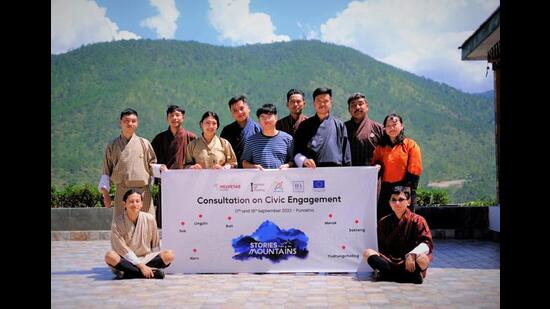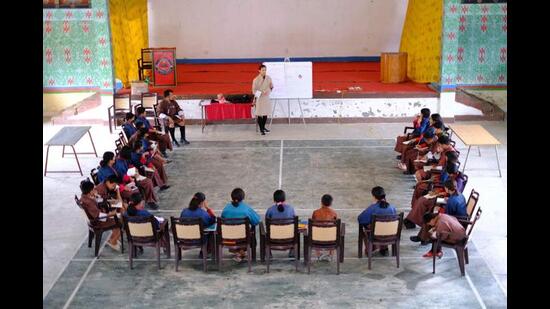Humans of Thimphu: An archive of portraits, one story at a time
Street photographer Tandin Phurba talks about building an archive of the hopes and dreams, struggles and triumphs of the people of Bhutan
Nagomi Tanabe, a Japanese expat in Bhutan, is a physiotherapist working as a volunteer of the Japan International Cooperation Agency at the Gyaltsuen Jetsun Pema Wangchuck Mother and Child Hospital in Thimphu. She knew little about the country before she arrived. But her father, who had been to the Himalayan Kingdom before, assured her of safety and its inherent ‘goodness’.

“To my surprise, Bhutan was more developed than I had imagined, with a lot of imported goods and cosy cafes,” she writes on humansofthimphu.com. Language was her foremost challenge. “I had learned everything in Japanese, so understanding medical vocabulary in English was tough. To communicate effectively with patients, I learned basic Dzongkha phrases, such as “Gatay naw may?” (Where is the pain?),” she writes.
Tanabe is one of the many whose stories have been chronicled by Humans of Thimphu, a project founded by Tandin Phurba, a self-taught street photographer, along the lines of the photoblog and book series, Humans of New York (HONY), which has become a cultural phenomenon since it was founded by American Brandon Stanton in November 2010.

Like HONY, the concept behind Humans of Thimphu is deceptively simple: Its website and social media handles feature portraits of individuals on the streets of Bhutan’s capital and provide a glimpse into their world — one story at a time. It’s an archive of their hopes and dreams, struggles and triumphs, created through a combination of visual and verbal storytelling. “Storytelling has always been a part of me. As a photographer, I have always been fascinated by capturing sights,” says Phurba, who was motivated to start the project during the pandemic. “While Covid-19 hit our nation, we were to stay home, isolated, and I felt that somehow we as humans had lost something essential in our lives: staying connected,” he recollects.
Since 2020, it has grown from its humble beginnings into a platform where over 15 young writers and photographers work tirelessly to showcase the stories of Thimphu’s residents. “We focus on individual stories as these ordinary lives make up the healthy community we live in, but what we have to remember is that the chaiwala uncle in the street is someone’s father, son, brother and a friend. No matter how small the role we play in society, we somehow contribute it into making up that community. The individual story that we share somehow brings our society together,” he says.
Phurba and his team have managed to create a space where people can freely share their stories, even on sensitive topics. For instance, they featured a story about a young girl in the central district of Zhemgang, who faced cyberbullying. “After we shared it on our website, thousands of people came together and sent her positive messages in our comments,” he says. When Phurba started 13 years ago, it took some time for people to understand the concept behind the platform.
“The people of Thimphu only knew about our mainstream media such as Bhutan Broadcasting Service (BBS) and Kuensel. When I first went out into the streets to collect stories, I thought I would get many because our people are friendly and supportive, but I returned home without any stories. Everyone kept asking me if I was from either BBS or Kuensel. Nobody knew what sharing their story on social media would look like,” he recalls.
That night, he and his designer decided to share their own stories to begin with. After his friend had shared his, it was Phurba’s turn. Reluctant to put out his own story, he went to a café and asked a member of the staff there if he would be interested in sharing his. He was. Soon, many more people became aware of the page. Phurba hasn’t looked back since.

In addition to being a platform for personal narratives, Humans of Thimphu has also become a window into Bhutanese culture and traditions. The project has showcased stories that celebrate the nation’s rich heritage and its cultural identity — the tugs of tradition, the pulls of modernity, and the subtle interplay of both.
“We’ve had specific stories about culture and tradition and how individuals from different age groups feel about development. Stories from the older set are tinged with a distaste for modernisation along with an acceptance of its inevitability and an appreciation of efforts to keep our culture intact. The younger generation too is very receptive to Bhutanese traditions. Our stories help bridge the gap between different age groups, and promote the preservation of culture,” says Phurba referring to the story of 13-year-old Tenzin. The middle-schooler joined a pazab (sacred warrior) group — an age-old tradition in Bhutan — during the Punakha Dromche (a local festival), following his apa and agay (parents), who have been doing it for many years now.
“I’ve always been proud of the fact that my family has been involved in such an important tradition. I want to be as amazing and popular a pazab as they are. Apart from that, I want to be a footballer. The rest of the year, when I’m not practising for the Dromche, I practise football. When I’m back in school after the break, I’ll share my experiences with my friends and maybe some of them will be interested enough to participate next year,” says Tenzin.

While Bhutan is often perceived as a nation solely focused on happiness, its people, like any other, experience a range of emotions. “We do not view happiness as the ultimate goal of life but as the process of accepting the experiences of unhappiness, dissatisfaction and despair and turning them into positive emotions. We believe that it is the phenomenon of being seen, understood and appreciated that starts the journey of happiness,” says Phurba who underlines the importance of photography in capturing raw emotions and readers deeper into the stories being told.
The photographic portraits evoke empathy and a genuine connection with the subjects. “Photography is one of many ways through which we capture the emotion of the person sharing his/her story. It allows our readers to dive deeper into the story and truly understand it. We always tell our subject to smile no matter what they are going through because it humanizes the story and brings more value to it,” he says.
Now, Humans of Thimphu looks set to go beyond storytelling. It has expanded its initiatives to include civic engagement workshops for young people and the establishment of libraries across Bhutan. A Humans of Thimphu book, that could empower people and foster positive change, is also in the works. In a digital age where superficiality often takes centre stage on social media, the team ensures that every story is fact-checked and that the quality and integrity of the content is maintained. They also focus on addressing pressing social issues such as gender-based violence, LGBTQ+ rights, mental health, and gender equality.

Bhutan’s connection to nature and its commitment to environmental conservation is well known across the world. While Humans of Thimphu has not directly illustrated this connection in its stories, it recognizes the importance of sustainable living and environmental consciousness. Many stories indirectly reference the changes in the environment that come with development, and highlight the Bhutanese citizens’ reverence for their pristine surroundings. The overarching message that Humans of Thimphu hopes to convey to its readers is one of empathy, connection, and the understanding that, no matter how different lives may seem, humans all share the universal experiences of joy, sorrow, and growth. “We want our readers to know that they are not alone. Someone might smile in front of you, but they might not be living the happy life that you think they are. So, spread kindness and love,” says Phurba.
Shireen Quadri is the editor of The Punch Magazine Anthology of New Writing: Select Short Stories by Women Writers.

All Access.
One Subscription.
Get 360° coverage—from daily headlines
to 100 year archives.



HT App & Website






